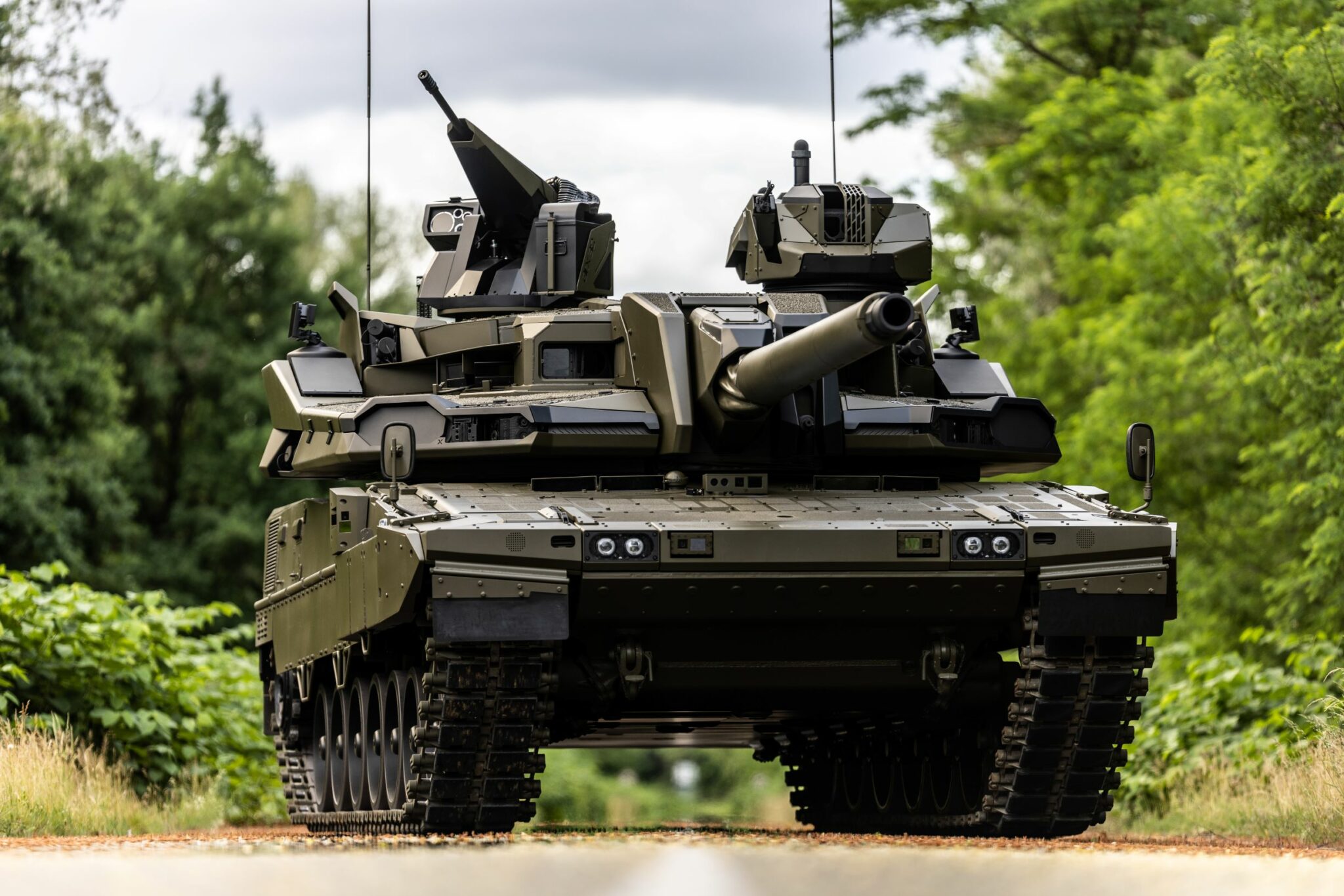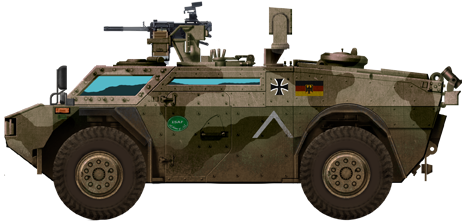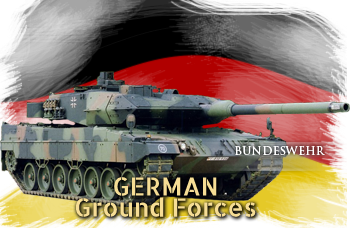The Reunification challenges
A source of immense relief in particular for the Berliners and separated families was the reunification that followed the destruction of the infamous wall and the dissolution of the GDR. The wall was erected in 1961, and only the peaceful Revolution 13 October 1989, followed by a final Settlement in 12 September 1990 and reunification 3 October 1990 ended this still very vivid and utterly sensitive part of the German memory and one of the most compelling situations provoked by the iron curtain and the cold war. However the reunion of 1/3 of the territory and people was just one side of the problem. Economically, East Germany was in shambles, and Bonn saw rapidly the “cost” of the whole “operation” of reunification not in a pleased way.
Articles
- Leopard 2A6/A3/M
- Leopard 2A7V
- Leopard 2A8
- Puma IFV
- GTK Boxer
- RCH-155
- ATF Dingo
- KMW Grizzly
- LGS Fennek
- Mercedes Enok
- Mowag Eagle IV
- Mowag Eagle V
- Yak
- ESK Mungo
- Panzerhaubitze 2000
- Wiesel 2 lePzMrs
- M113 GA2 PzMsr
- M113 Abra
- PiPz 3 Kodiak AEV
- Leguan
- BPZ3 Buffalo ARV
- EH/W200 Bison ARV
- Liebherr G-BKF ARV
- Liebherr G-LTM 1090 ARV
- Fuchs Kai
- Fuchs Para
- Fuchs Hummel
- Fuchs RMB
- Fuchs Eloka/Peiler
- RMT RCSYS bot
- KMW Mogefa EWT
The integration of the NVA
As a side note for what we are concerned for, the Bundeswehr inherited large stockpiles of obsolete/worn-out soviet or locally-built armoured vehicles. Due to NATO standard, most have been simply put in storage pending scrapping, but some vehicles were kept only for local security purposes pending replacement. The East German Army (Nationale Volksarmee or NVA) indeed, established in 1956 was disbanded in 1990, but still strong of 767 aircraft (helicopters and fixed wing aircraft of which 24 were MiG-29s), 208 ships, 2,761 tanks, 133,900 wheeled vehicles, and 2,199 artillery pieces among others.
A Compulsory service 18 of month had been established in 1961, and faithful to the soviet tactics of the time, relied on large numbers of these conscripts for operations, among these the Kampfgruppen der Arbeiterklasse (milita of workers) that a bit like a reserve army received little training in a regular basis after being draft in compulsory service. This auxiliary party militia was 210,000 strong and can be mobilized rapidly in case of war, along with three mobilisation divisions and two reserve divisions in D+2.
The regular Landstreitkräfte (Ground Forces) had a strength of 108,000 men, distributed among 9 motorized divisions (Motorisierte-Schützen-Division) and two Armoured divisions based at Dresden and Eggesin. Among specific units that were disbanded were the 50,000 strong BDR (Kommando der Grenztruppen) border guards operating along the wall.
Hardware inherited from the Landstreitkräfte in 1990
Among the 2,761 tanks were BMP-1 and BMP-2 IFVs (Panzergrenadier units), BRDM-1 and BRDM-2 Amphibious armoured recce vehicles, BTR-40, BTR-152, BTR-50, 60 and 70 APCs (Which formed the bulk of the motorized units), PT-76 Amphibious light tanks, some T-34 converted in modified recovery/engineering versions, T-54 or various versions manufactured in Poland and Czechoslovakia (reserve), T-55 upgraded to the T-55AM standard and T-72s of Polish, Czech and soviet manufacture which formed the bulk of the MBT force.
The new Bundeswehr
The Heer absorbed the army of East Germany, starting on 30 June 1991. After the merger, the new Bundeswehr was 360,000 men strong dispatched in four corps (one created with the former East German army), but the end of the cold war had an immediate effect of downsizing it over the years. Changes included the III Corps being reorganised as the German Army Forces Command (1994) and the 25th Airborne Brigade being converted into a the special forces leading unit, known as the Kommando Spezialkräfte. The IV corps based in Potsdam in east Germany heads the 13 and 14th Panzer-Grenadier Divisions.
It took years for the ex-East German Armoured vehicles to be “digested” and recycled. The remainder made the day of private collectioners and museums around the world. This did not change much the organization of the Bundeswehr but the creation of new military districts, often based on the ancient ones in East Germany, although many bases and barracks were closed, the BDW being a smaller professional army as opposed to a conscript army.
By the 2001 reforms, the army was scaled down once more, to a seven divisional structure: 5 mechanized (2 mechanized brigades each), 1 special forces, and one airmobile (three corps). Emphasis was put on the creation of a rapid reaction force to be dispatched in foreign theaters of operations. In 2003 a joint German/Dutch Corps, was constituted for peacetime operations with the 1st Panzer and 7th Panzer Divisions Dutch formations. The 7th PZD was put at the disposal of the Allied Rapid Reaction Corps. Before 2001 the IIth corps would have exchanged a division (5th PZD) with the 5th US Corps. The 10th PZD, also part of this IIIth corps was allocated to the Eurocorps representing the German half of the Franco-German Brigade. A new reorganization until 2012 saw the Corps disbanded or replaced by multinational corps. Although heavy brigade did not changed, HQ of several units were merged (mostly by cost constraints) like the Airmobile Operations Division and Special Operations Division headquarters, while the 13th Mechanized Infantry Division headquarters was disbanded in 2012 as the 1st Airmobile Brigade. In 2015 the Heer represents 60,857 soldiers in active duty. Specific to the the German Army, regiments are rare and Battalions are directly subordinate to brigades or divisions as divisional troops.
Interventions:
The BDW intervened under the UN banner in Somalia in 1995-97 (UNITAF then UNOSOM II), in ex-Yugoslavia 1995-99 (IFOR in Bosnia and Herzegovina), an more specifically took part to the Operation Libelle during the Albanian riots in 1997. German troops also participated in the KFOR responsible to peace keeping operations in Kosovo (1988-99), operations during and after the battle of Tetovo (Macedonia) in 2001, as known as Operation Essential Harvest altogether with French and Spanish NATO troops. More famously German troops were deployed in the 2000s in Afghanistan as part of ISAF, deploring 57 casualties at the end of the intervention. 850 German troops were deployed in Operation Resolute Support until 2014, as part of NATO.
In 2011 (the last known intervention in Europe of the BDW) German troops took part in KFOR deployed in North Kosovo during the crisis.
Legacy Vehicles

TPZ Fuchs (1979): Wheeled APC and Chemical recce vehicle, still 765 in service, 144 currently in an upgrade process.
EMBT, the MGCS program

The Franco-German European Main Battle Tank (EMBT) is a collaborative effort between France and Germany to develop a next-generation main battle tank. Announced in 2017, the EMBT project aims to combine the expertise and resources of both countries to create a highly capable and advanced armored vehicle for their respective armed forces. Key points:
Collaborative Development: The EMBT project represents a significant step in European defense cooperation, with France and Germany pooling their resources to develop a shared platform. The tank is a product of cooperation between French defense contractor Nexter Systems and German defense company Krauss-Maffei Wegmann (KMW).
Leclerc and Leopard 2 Basis: The EMBT is based on existing platforms: the French Leclerc main battle tank and the German Leopard 2. By leveraging the strengths of these two battle-proven designs, the EMBT seeks to combine the best features of both tanks into a single, advanced platform.
Enhanced Features: The EMBT incorporates various enhancements and upgrades over its predecessors. These may include improvements in firepower, mobility, protection, and battlefield networking capabilities. Specific details about the features and specifications of the EMBT are subject to ongoing development and may evolve over time.
Operational Flexibility: As a next-generation main battle tank, the EMBT is designed to operate effectively across diverse combat environments, ranging from open terrain to urban areas. It is intended to fulfill a range of battlefield roles, including engaging enemy armor, supporting infantry operations, and conducting reconnaissance missions.
European Defense Integration: The development of the EMBT reflects broader efforts within Europe to enhance defense integration and strengthen the continent's defense capabilities. By collaborating on projects like the EMBT, European nations aim to reduce duplication, increase interoperability, and bolster their collective defense posture.
Future prospects
The big game changer in that matter was the war in Ukraine and exceptional vote by the Bundestag of a massive 2 billion Euros in 2022.Modern equipments of the Heer:
 Leopard 2A5 (1990)
Leopard 2A5 (1990)

The standard version released in 1990, right at the end of the cold war. It was a considerable leap forward in armour which was completely overhauled and improved, especially for the turret. It was even superior to any other protection designs anywhere at the time. It is also known as the “short barrel” compared to the 2A6. The 2A5 is now in storage, upgraded to the 2A6 standard or has been exported.
 Leopard 2A6 (1998)
Leopard 2A6 (1998)

This new version of the Leopard 2 was introduced in 1998 and distinguished itself by a new, long 120 mm L/55 Rheinmetall barrel. It has the same upgraded armour as the previous Leopard 2A5 (1987). Older version were gradually upgraded or sold. KMW also produce the 2A7+ for tanks with extended urban combat capabilities. The “revolution” package came as an export upgrade. In total 250 are in service today, including 135 Leopard 2A6, 70 Leopard 2A6M, 20 Leopard 2A7+.
 Leopard 2A7 (2017)
Leopard 2A7 (2017)

The Krauss-Maffei Wegmann (KMW) Leopard 2A7 is a state-of-the-art German main battle tank (MBT) that builds on the legacy of the Leopard 2 series. It incorporates numerous upgrades to improve its performance in modern warfare, particularly in urban and high-intensity conflicts. It had Modular composite armor for improved protection against kinetic energy (KE) and explosive projectiles, increased protection against mines and improvised explosive devices (IEDs), and an optional, advanced active protection system. Still armed with the 120mm Rheinmetall L55 smoothbore but firing kinetic energy rounds and programmable high-explosive ammunition. It has an advanced fire control system for superior accuracy, even while on the move. There is a coaxial machine gun but also an optional remote-controlled weapon station (RCWS) on the roof.
It is still Powered by a 1,500-horsepower MTU MB 873 Ka-501 turbocharged diesel engine for c70 km/h (43 mph) on roads, 50 km/h (31 mph) off-road, riding on enhanced suspension and chassis modifications. It has a fully upgraded optics and sensors suite, with the latest thermal imaging system and a state of the art battlefield management systems (BMS) for real-time data sharing and coordination. It is also Optimized for operations in urban environments with enhanced survivability and versatility, better awareness with more cameras. Like the DSO it could receive a dozer blade for clearing obstacles. Therse is an Improved climate control system for extreme weather conditions and more ergonomically designed interior for better crew efficiency and reduced fatigue.
The Leopard 2A7 was acquired either as new built or upgraded, to Hungary and Qatar among others.
 Puma IFV (2015)
Puma IFV (2015)

This brand new IFV is intended to replace the older Marder IFV. 349 Schützenpanzer Puma are in order, deliveries started in june 2015.
 GTK Boxer (2008)
GTK Boxer (2008)

New 8×8 APC of the Bundeswehr, replacing the Fuchs.272 in service, 131 in order.
 ATF Dingo (2000)
ATF Dingo (2000)

Standard IMV (Infantry Mobility Vehicle) of the Bundeswehr, tailored for low/medium intensity areas. 550 in service.
 LGS Fennek (2000)
LGS Fennek (2000)

4×4 recce vehicle of the German Army, also produced by and for the Netherlands. 222 in service.
 KMW Grizzly MRAP (2007)
KMW Grizzly MRAP (2007)

Standard 6×6 heavy MRAP of the Bundeswehr. Joint production with Iveco in Italy. Primarily an armored personal carrier equipped with advanced ballistic and mine protection systems, designed to safeguard crew against a variety of threats in combat zones. With a 6x6 chassis it stays highly maneuverable in rough terrain and urban environments, leveraging its powerful engine and advanced suspension systems. Also known as the Iveco MPV 4x4-6x6. The name was changed to GFF4.
 Enok (2002)
Enok (2002)

Standard light recce vehicle, developed on the Mercedes Benz G chassis as a light utility recce/liaison vehicle. 331 are in service.
 Mowag Eagle IV/V (2003)
Mowag Eagle IV/V (2003)

Standard medium 4×4 MRAP. Built by Mowag Switzerland. 495 in service.
 Panzerhaubitze 2000 (1998)
Panzerhaubitze 2000 (1998)

Standard self propelled howitzer of the Bundeswehr. Also in service in Italy and the Netherlands. 154 in service but 81 are to be kept active due to budget constraints.
Sources/Links
The Heeres today
Modern German army equipments

Modern Tanks
Modern MBTs posters

Denel Bagder (2018)

Type 16 MCV (2016)

Gepard 1A2 last rounds 2011

SANDF

Russian AFVs

Main Battle Tanks

